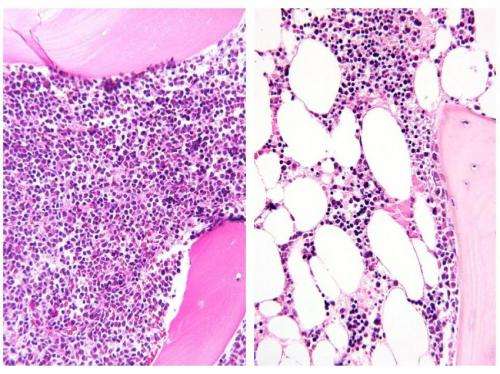Obese youths with leukemia more likely to have persistent disease

Obese youths with acute lymphoblastic leukemia (ALL) are known to have worse outcomes than their lean counterparts. To find out why, investigators at Children's Hospital Los Angeles studied patients who were obese at the time of their diagnosis with ALL to determine if body mass index (BMI) impacted response to initial chemotherapy. This response to initial chemotherapy (or induction therapy) is measured by the absence of leukemia cells in the bone marrow. Called minimal residual disease (MRD), in which residual leukemia cells cannot be seen under microscope but can be detected by more sensitive methods, it is among the strongest predictors of long-term survival and disease recurrence. As reported in First Edition of the journal Blood on October 27, following induction chemotherapy, obese patients were more than twice as likely to have minimal residual disease, than non-obese patients.
"Induction chemotherapy provides a patient's best chance for remission or a cure," said principal investigator Steven Mittelman, MD, PhD, of The Saban Research Institute of Children's Hospital Los Angeles. "Our findings indicate that a patient's obesity negatively impacts the ability of chemotherapy to kill leukemia cells, reducing the odds of survival."
The study looked at 198 patients, diagnosed with ALL and between the ages of 1 and 21 years. Each patient's BMI was converted to a percentile and classified according to CDC thresholds for overweight (85 to 94%) and obese (greater than 95%). Patients at less than 85% BMI were considered "lean". About one-third of the patients were obese or overweight at the time of diagnosis.
MRD was determined by testing of bone marrow specimens taken at the end of induction therapy, and patients were followed for two to five years from the time of diagnosis. The investigators found that lean patients with minimal residual disease had similar outcomes to obese patients without evidence of residual disease. Obese patients with residual disease had the worst outcomes. Additionally, although nearly a quarter of the patients initially deemed "lean" gained weight and become obese during the first month of treatment, these patients still showed similar outcomes to those who remained lean.
"In addition to increasing a patient's likelihood of having persistent disease following treatment, obesity appears to add a risk factor that changes the interaction between chemotherapy and residual leukemia cells," said Hisham Abdel-Azim, MD, of The Saban Research Institute of Children's Hospital Los Angeles and co-lead investigator on the study. Abdel-Azim also explained that the investigators were able to examine this interaction in a large number of patients because CHLA had established MRD testing and made it available to all patients before it became widely used as the of standard of care.
Findings from this study offer new avenues for investigation that include modifying chemotherapy regimens for obese patients and working to change a patient's weight status beginning at the time of diagnosis.














